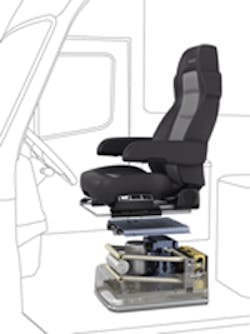The Bose Corp. is entering the truck market with a product it says will improve driver health, comfort and safety while reducing fatigue by nearly eliminating road vibration and shocks. Designed to replace a typical air-ride seat, the new Bose Ride system incorporates several patented technologies to actively counteract what it characterizes as the most damaging “whole-body vibration” routinely endured by heavy-duty truck drivers.
The new Bose seat packages a high-speed electromagnetic actuator, a power amplifier, an electronic control unit as powerful as the ones typically found on a heavy-duty diesel, and sensors underneath an integrated driver’s seat. The seat and base can be installed in most heavy-duty trucks in approximately two hours using the existing seat bolts, air line and a 12V power connection, according to the company.
Although it’s widely known for its consumer audio and electronic products, Bose has been actively researching and developing automotive suspension technology since 1980, according to company founder Dr. Amar Bose.
While that research has yet to product a commercial auto suspension system, 10 years ago the company recognized that the core technology could be applied to over-the-road trucks, said Michael Rosen, chief engineer for research and development. Exposure to whole-body vibration can damage a driver’s health by stressing the spine, contribute to fatigue both in and out of the truck, impair visual perception and generally reduce driver comfort, according to Rosen, who said such vibration “is experienced continuously in a truck cab.”
Conventional air-ride seat suspensions offer some isolation from road shocks and vibrations, but involve tradeoffs that cannot fully protect drivers from sharp inputs such as potholes and the more general vibration induced by road surface imperfections, according to Jim Parison, the lead engineer on Bose’s truck-seat project.
A “passive device” that can only react mechanically to inputs, an air-ride seat set to smooth out vibration will bottom out on sharp drops, delivering a jolt to the driver’s spine, Parison said. However, increasing seat air pressure to protect against sharp inputs will transmit all the smaller road vibrations to the driver’s torso, he said.
The Bose Ride system actively counteracts both sharp inputs and vibration, greatly nearly eliminating them for the driver’s body and keeping the driver’s head steady and level even over washboard or undulating roads, according to Perison.
(View video of seat comparison)
In tests based on ISO specifications for whole-body vibration exposure, air-ride seats exceeded the group’s “health caution zone” on local roads and highways, while the Bose system was well below that level and equaled or even outperformed passenger vehicles, according to a Bose white paper authored by Parison. The same paper cited a four-week field test of the Bose seat with 77 OTR drivers where 84% reported improved comfort, 75% said it reduced soreness and stiffness and 66% said it decreased driving fatigue.
The Bose Ride system uses an electromagnetic actuator that can quickly react to sensor inputs according to proprietary algorithms developed over the last 10 years by the Bose research team, Parison said. Power for the actuator, which can require up to 3,500 watts to react to those inputs, is provided by a regenerative amplifier that converts the vibration/shock energy into electrical power and stores it, drawing only 50 watts from the truck’s electrical system.
In the event of a failure, the system is designed to default to a standard air-ride suspension. Mechanical linkages and bushings are also beefier than those found in a typical air-ride seat to withstand the nearly constant and strong inputs from the actuator, creating a maintenance-free seat assembly, Parison said. The seat top is provided by “a major truck-seat manufacturer,” he said.
The integrated seat, actuator, amplifier and ECU will be sold directly by Bose to fleets, according to company CEO Bob Maresca. Only willing to say that the price would be “well under $10,000,” Maresca said the Bose Ride would be available on a build-to-order basis for volume purchases by fleets starting in March.
The system will be built at Bose’s headquarter and manufacturing facilities in Framingham, MA., and the company will also provide installation training for fleet customers.
About the Author
Jim Mele
Jim Mele is a former longtime editor-in-chief of FleetOwner. He joined the magazine in 1986 and served as chief editor from 1999 to 2017.
